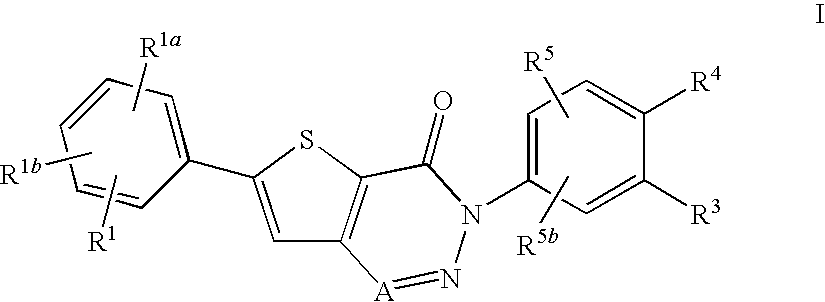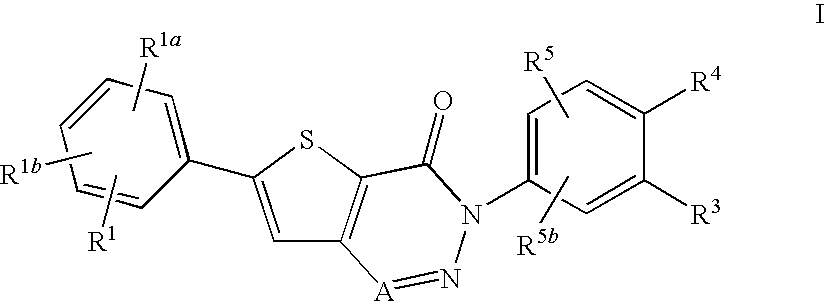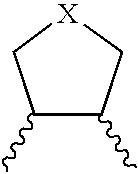Non-basic melanin concentrating hormone receptor-1 antagonists
a hormone receptor and non-basic melanin technology, applied in the field of non-basic melanin concentrating hormone receptor1 antagonists, can solve the problems of increased food intake, weight loss, and decreased feeding in diet-induced obese mi
- Summary
- Abstract
- Description
- Claims
- Application Information
AI Technical Summary
Problems solved by technology
Method used
Image
Examples
example 1
6-(4-Chlorophenyl)-3-(4-(2-hydroxy-2-methylpropoxy)-3-methoxyphenyl)-thieno[3,2-d][1,2,3]triazin-4(3H)-one
[0123]
A. 3-Amino-5-(4-chlorophenyl)thiophene-2-carboxylic acid
[0124]
[0125]The title compound was prepared according to the procedure described in patent application WO 2007 / 011286.
B. 1-(4-Amino-2-methoxyphenoxy)-2-methylpropan-2-ol
[0126]
[0127]The title compound was prepared following the procedure described in U.S. Provisional Application No. 60 / 730,453.
C. 3-Amino-5-(4-chlorophenyl)-N-(4-(2-hydroxy-2-methylpropoxy)-3-methoxyphenyl)thiophene-2-carboxamide
[0128]
[0129]Following addition of O-(7-azabenzotriazol-1-yl)-N,N,N′,N′-tetramethyluronium hexafluorophosphate (HATU) (571 mg, 1.50 mmol) and N,N-diisopropylethyl-amine (0.64 mL, 3.67 mmol) to a solution of the amide described in Part A of Example 1 (298 mg, 1.17 mmol) in NMP (6.0 mL) were added, the resulting solution was stirred at RT for 2 h. A solution of the aniline described in Part B (257 mg, 1.22 mmol) in CH2Cl2 (2.0 mL) w...
example 2
6-(4-Chlorophenyl)-3-(3-methoxy-4-(2-oxopropoxy)phenyl)thieno[3,2-d][1,2,3]triazin-4(3H)-one
[0132]
A. 2-Methoxy-4-nitrophenyl acetate
[0133]
[0134]Following addition of acetyl chloride (0.50 mL, 7.10 mmol) to a solution of 4-nitroguaiacol (1.00 g, 5.91 mmol) and pyridine (0.52 mL, 7.10 mmol) in CH2Cl2 (10 mL) at RT, the mixture was stirred at RT for 30 min. The mixture was washed with 1M HCl (2×5 mL), dried (Na2SO4) and concentrated to provide the desired acetate (1.24 g, quant.) as a pale yellow solid: MS (electrospray, + ions) m / z 212 (M+H).
B. 4-Amino-2-methoxyphenyl acetate
[0135]
[0136]To a stirred solution of the 2-methoxy-4-nitrophenyl acetate prepared in Part A (99.2 mg, 0.47 mmol) in EtOAc (4.5 mL) was added palladium on carbon (33.0 mg, 5% dry basis, Degussa type: 50% water content). The suspension was hydrogenated (1 atm, balloon) for 3 h, filtered through Celite and the filter cake was rinsed with MeOH (5×10 mL). Evaporation of the combined filtrates gave the desired aniline (...
example 3
6-(4-Chlorophenyl)-3-(4-(2-hydroxypropoxy)-3-methoxyphenyl)thieno[3,2-d][1,2,3]triazin-4(3H)-one
[0145]
[0146]A stirred suspension of the methyl ketone prepared in Part F of Example 2 (15.6 mg, 0.035 mmol) in methanol (3.0 mL) and THF (1.5 mL) was stirred for 6 h at RT with NaBH4 (1.8 mg, 0.05 mmol); whereupon, an additional amount of NaBH4 (1.8 mg, 0.05 mmol) was added. After stirring an additional 2.6 h, the mixture was cooled to 0° C. and diluted with phosphate buffer (8 mL, 0.5M KH2PO4). The aqueous mixture was stirred at RT for 2 h after sufficient H3PO4 was added to lower the pH to 3 and then was extracted with CH2Cl2 (3×20 mL). The combined organic extracts were dried (Na2SO4) and concentrated. Chromatography (SiO2 230-400 mesh, 3 / 2 CH2Cl2 / EtOAc) of the crude furnished the desired final product. (15.1 mg, 96% yield) as a yellow solid: MS (electrospray, + ions) m / z 444 (M+H); 1H NMR ∂ (CDCl3) 7.75 (s, 1H), 7.69 (d, J=8.6 Hz, 2H), 7.51 (d, J=8.6, 2H), 7.21 (dd, J=8.4, 2.6 Hz, 1H)...
PUM
| Property | Measurement | Unit |
|---|---|---|
| temperatures | aaaaa | aaaaa |
| temperatures | aaaaa | aaaaa |
| temperatures | aaaaa | aaaaa |
Abstract
Description
Claims
Application Information
 Login to View More
Login to View More - R&D
- Intellectual Property
- Life Sciences
- Materials
- Tech Scout
- Unparalleled Data Quality
- Higher Quality Content
- 60% Fewer Hallucinations
Browse by: Latest US Patents, China's latest patents, Technical Efficacy Thesaurus, Application Domain, Technology Topic, Popular Technical Reports.
© 2025 PatSnap. All rights reserved.Legal|Privacy policy|Modern Slavery Act Transparency Statement|Sitemap|About US| Contact US: help@patsnap.com



